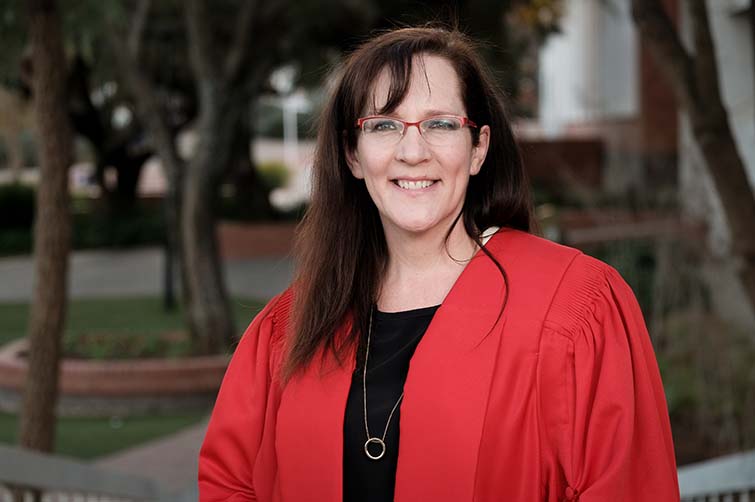25 August 2025
|
Story Martinette Brits
|
Photo Stephen Collett
 Prof Elizabeth Erasmus during her inaugural lecture, Molecules of Change: Chemistry for a Better Tomorrow, on 20 August, highlighting how innovative chemistry can turn waste into value and promote sustainable solutions.
Prof Elizabeth Erasmus during her inaugural lecture, Molecules of Change: Chemistry for a Better Tomorrow, on 20 August, highlighting how innovative chemistry can turn waste into value and promote sustainable solutions.
With climate change, resource scarcity, and environmental pollution among the most pressing challenges of our time, Prof Elizabeth (Lizette) Erasmus used her inaugural lecture on Wednesday, 20 August to show how chemistry can provide powerful, practical answers. In her lecture, Molecules of Change: Chemistry for a Better Tomorrow, she traced her journey from fundamental research to pioneering innovations that turn waste into value, protect ecosystems, and improve food security.
During her talk, Prof Erasmus – Researcher in the Department of Chemistry – recalled a moment in 2018 that reshaped her career trajectory. While preparing a Sasol research grant on copper oxide nanoparticles, an entrepreneur assisting with the proposal posed a deceptively simple challenge: “So what?” “Although upsetting at first, those two words completely reshaped my outlook,” she explained. “They inspired my journey from purely academic chemistry towards more applied, impactful research – with the mission of not only advancing science, but of also improving society and the environment.”
From fundamental science to global solutions
Prof Erasmus began her career in organometallic chemistry, preparing and characterising complex molecules to understand their reactivity and physical properties. Later, her focus shifted to heterogeneous catalysis, where she explored nanomaterials and surface chemistry.
Her research has since evolved towards developing sustainable technologies that address urgent global challenges. One example is agricultural innovation: using green solvents to extract cellulose from wattle tree bark to create biodegradable superabsorbent polymers. “Unlike the polyacrylates in baby diapers, these SAPs degrade into nutrients for soil microbes and plants,” she explained. “By loading them with fertiliser, we develop slow-release, water-retaining materials that improve agricultural sustainability.”
Other projects include producing biochar to restore degraded soils, creating natural growth enhancers such as wood vinegar, and designing an ‘ultimate fertiliser’ that combines these products for long-term soil health. Her group also works on environmental remediation, developing hydrophobic sponges to absorb oil spills, repurposing building waste to clean polluted water, and using innovative chemistry to convert carbon dioxide into valuable products.
“We are even looking at one of the fastest-growing waste streams: e-waste,” Prof Erasmus noted. “With more gold per ton than natural ore, e-waste represents both a challenge and an opportunity. By developing porous absorbent materials, we can selectively capture and reduce gold ions directly to metallic gold – recovering a precious resource from waste.”
She concluded by crediting her team and collaborators: “This, however, is only the tip of the iceberg. The bulk of the work lies beneath the surface, carried out by dedicated students, collaborators, mentors, colleagues, friends, and family. I owe them my deepest gratitude, for they are the ones who truly sustain this journey of transforming chemistry into solutions for a better world.”
About Prof Erasmus
Prof Elizabeth (Lizette) Erasmus obtained all her degrees at the University of the Free State: a BSc (2001), BSc Honours in Chemistry (2002), MSc in Chemistry (2003), and a PhD in Chemistry (2005). She has published more than 80 research papers, holds an H-index of 21, and has extensive experience in supervising MSc and PhD students.
After serving as a senior researcher at the CSIR, she returned to academia at the UFS, where her international collaborations in the Netherlands and at UC Davis broadened her focus from organometallic chemistry to heterogeneous catalysis and nanochemistry. Her expertise spans organometallic chemistry, electrochemistry, surface characterisation, and nanomaterials.